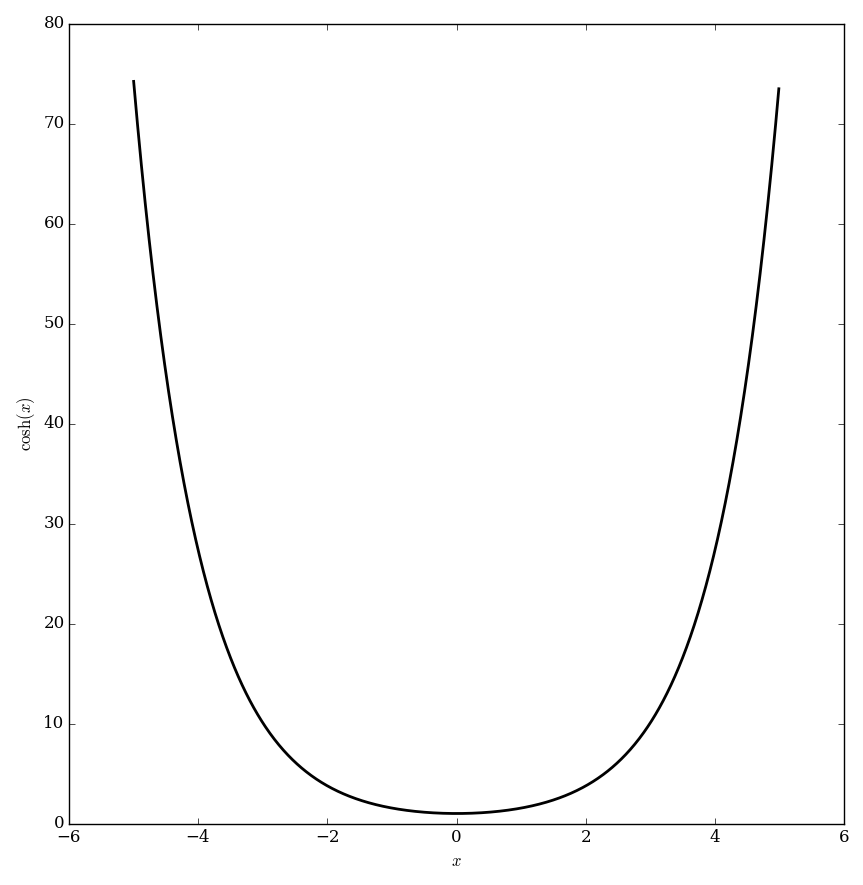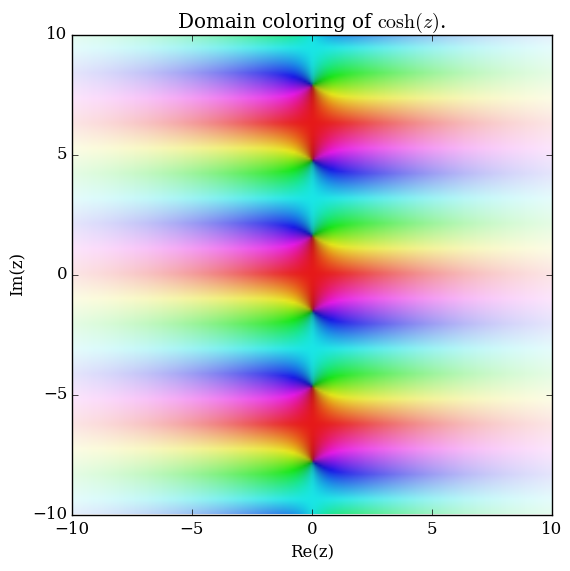Difference between revisions of "Cosh"
| Line 1: | Line 1: | ||
| − | The hyperbolic cosine function is defined by | + | The hyperbolic cosine function $\cosh \colon \mathbb{C} \rightarrow \mathbb{C}$ is defined by |
$$\mathrm{cosh}(z)=\dfrac{e^z + e^{-z}}{2}$$ | $$\mathrm{cosh}(z)=\dfrac{e^z + e^{-z}}{2}$$ | ||
Revision as of 02:43, 2 June 2016
The hyperbolic cosine function $\cosh \colon \mathbb{C} \rightarrow \mathbb{C}$ is defined by $$\mathrm{cosh}(z)=\dfrac{e^z + e^{-z}}{2}$$
Domain coloring of analytic continuation of $\cosh$.
Contents
- 1 Properties
- 1.1 Theorem
- 1.2 Proof
- 1.3 References
- 1.4 Theorem
- 1.5 Proof
- 1.6 References
- 1.7 Theorem
- 1.8 Proof
- 1.9 References
- 1.10 Theorem
- 1.11 Proof
- 1.12 References
- 1.13 Theorem
- 1.14 Proof
- 1.15 References
- 1.16 Theorem
- 1.17 Proof
- 1.18 References
- 1.19 Theorem
- 1.20 Proof
- 1.21 References
- 1.22 Theorem
- 1.23 Proof
- 1.24 References
- 1.25 Theorem
- 1.26 Proof
- 1.27 References
- 2 See Also
Properties
Theorem
The following formula holds: $$\dfrac{\mathrm{d}}{\mathrm{d}z} \cosh(z) = \sinh(z),$$ where $\cosh$ denotes the hyperbolic cosine and $\sinh$ denotes the hyperbolic sine.
Proof
From the definition, $$\mathrm{cosh}(z)=\dfrac{e^z + e^{-z}}{2}$$ and so using the derivative of the exponential function, the linear property of the derivative, the chain rule, and the definition of the hyperbolic sine, $$\dfrac{\mathrm{d}}{\mathrm{d}z} \cosh(z)=\dfrac{e^z - e^{-z}}{2}=\sinh(z),$$ as was to be shown. █
References
Theorem
The following formula holds: $$\cosh^2(z)-\sinh^2(z)=1,$$ where $\cosh$ denotes the hyperbolic cosine and $\sinh$ denotes the hyperbolic sine.
Proof
From the definitions $$\cosh(z)=\dfrac{e^{z}+e^{-z}}{2}$$ and $$\sinh(z)=\dfrac{e^{z}-e^{-z}}{2},$$ we see $$\begin{array}{ll} \cosh^2(z) - \sinh^2(z) &= \left( \dfrac{e^{z}+e^{-z}}{2} \right)^2 - \left( \dfrac{e^{z}-e^{-z}}{2} \right)^2 \\ &= \dfrac{1}{4} \left( e^{2z}+2+e^{-2z}-e^{2z}+2-e^{-2z} \right) \\ &= 1, \end{array}$$ as was to be shown. █
References
- 1964: Milton Abramowitz and Irene A. Stegun: Handbook of mathematical functions ... (previous) ... (next): $4.5.16$
Theorem
The Weierstrass factorization of $\cosh(x)$ is $$\cosh x = \displaystyle\prod_{k=1}^{\infty} 1 + \dfrac{4x^2}{(2k-1)^2\pi^2}.$$
Proof
References
Theorem
The following formula holds: $$\cosh(az)=az {}_0F_1 \left( ; \dfrac{1}{2}; \dfrac{(az)^2}{4} \right),$$ where $\cosh$ denotes the hyperbolic cosine and ${}_0F_1$ denotes the hypergeometric pFq.
Proof
References
Theorem
The following formula holds: $$I_{-\frac{1}{2}}(z)=\sqrt{\dfrac{2}{\pi z}} \cosh(z),$$ where $I_{-\frac{1}{2}}$ denotes the modified Bessel function of the first kind and $\cosh$ denotes the hyperbolic cosine.
Proof
References
Theorem
The following formula holds: $$\cosh(z)=\cos(iz),$$ where $\cosh$ is the hyperbolic cosine and $\cos$ is the cosine.
Proof
References
- 1964: Milton Abramowitz and Irene A. Stegun: Handbook of mathematical functions ... (previous) ... (next): $4.5.8$
Theorem
The following formula holds: $$\cos(z)=\cosh(iz),$$ where $\cos$ is the cosine and $\cosh$ is the hyperbolic cosine.
Proof
From the definition of $\cosh$ and the definition of $\cos$, $$\cosh(iz)=\dfrac{e^{iz}+e^{-iz}}{2}=\cos(z),$$ as was to be shown.
References
Theorem
The following formula holds: $$\sec(\mathrm{gd}(x))=\cosh(x),$$ where $\sec$ denotes the secant, $\mathrm{gd}$ denotes the Gudermannian, and $\cosh$ denotes the hyperbolic cosine.
Proof
References
Theorem
The following formula holds: $$\cosh(\mathrm{gd}^{-1}(x))=\sec(x),$$ where $\cosh$ is the hyperbolic cosine, $\mathrm{gd}^{-1}$ is the inverse Gudermannian, and $\sec$ is the secant.

